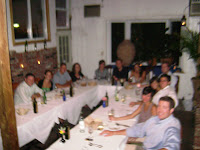
At our last Business Over Breakfast meeting, we were fortunate to have Brookings Institute fellow Christopher Leinberber talk about the renewed interest in downtowns and how he thinks it will play out.
The gist of his presentation is expanded in his new book, The Option of Urbanism, and it follows a storyline that will be familiar to frequent readers of this blog - that, for any number of reasons, more and more people are opting for new urbanist lifestyles in walkable urban communities.
Leinberger doesn't herald the end of suburban living, but he clearly feels that new generations are being both pulled to downtown living, and pushed away from suburbia's car dependant isolation and energy inefficiency. And he strongly encourages an end to land use patterns and development incentives that led to the creation of the suburbs at the expense of urban centers in the first place.
The book is cited by Alan Ehrenhalt in a fascinating article in The New Republic (Trading Places, The Demographic Inversion of the American City, published on August 13, 2008) in which he goes beyond merely documenting renewed interest in downtown living to show that affluence is moving into cities from the suburbs and vice versa.
He cites examples in a range of places - Atlanta, Chicago, Charlotte, Vancouver, Washington, DC - where a "demographic inversion" may eventually cause these places to resemble the great capitals of Europe, having wealth concentrated in the hearts of cities and poverty dispersed to the hinterland.
According to Ehrenhalt, several trends back his assertion up:
-De-industrialization has removed the grime, pollution, and noise that characterized cities in the early- and mid-20th century.
-Most people recognize that urban crime is not random, and that younger generations do not grow up with the fear of street muggings that their parents and grandparents may have had.
-That the cultural icons of Gen Y are urban. "This is the generation that grew up watching Seinfeld, Friends, and Sex and the City..." not Leave it to Beaver.
-Finally, that fuel costs are more related to dwindling worldwide supply in the face of heightened demand and, therefore, more likely to have long-term implications on personal behavior than did the OPEC-induced fuel crises in the 1970s. In other words, people will drive less and live in communities where they can walk more.
 While these trends are positives for cities, he writes that, "demographic inversion cannot be a one-way street. If some people are coming inside, some people have to be going out." Race is an issue, he writes, but economic status may have more to do with who lives where.
While these trends are positives for cities, he writes that, "demographic inversion cannot be a one-way street. If some people are coming inside, some people have to be going out." Race is an issue, he writes, but economic status may have more to do with who lives where.In Baltimore, Downtown's residential growth (within a one-mile radius of Pratt & Light Streets) has displaced underused commercial and manufacturing spaces not people, for the most part. (No one was living in Harbor East or City Center until a few years ago.) And we were one of the first major cities to replace our high rise public housing, what Ehrenhalt refers to as "Vertical Corbusian ghettoes" with mixed-income, mixed ownership townhouse communities.
And Baltimore is ahead of the curve when it comes to inclusionary zoning. Residential developments that receive taxpayer funds are under new mandates to provide affordable units, for example.
It's not easy to respect the force of the market on the one hand, while creating new opportunities for economic and racial diversity on the other. But it's a process that's worth getting right and Baltimore is working in that direction.
Downtowns are, and should be, melting pots where people of different backgrounds come together to exchange in commerce, ideas, and the arts. Ehrenhalt thinks this will happen. That people's craving for "community" will bring them together and that even the priciest enclaves will want to be a part of the street scene, not gated from it.
-Mike Evitts

































